Integrated Business Research Methods: Research Design Report
VerifiedAdded on 2022/09/29
|9
|2805
|32
Report
AI Summary
This report delves into the realm of integrated business research methods, outlining a comprehensive approach to conducting effective research. The report begins by defining research design and advocating for a mixed-methods approach, specifically utilizing a sequential explanatory design that combines quantitative and qualitative methodologies. It then explores the philosophical underpinnings, embracing pragmatism to allow flexibility in method selection based on research questions. The report details the use of survey questionnaires for quantitative data collection, including question types, scales of measurement, and demographic considerations. Additionally, it describes the implementation of semi-structured interview questionnaires for qualitative data, emphasizing the importance of adaptability and open-ended questioning. The report emphasizes the suitability of these instruments for achieving research objectives, followed by an explanation of data collection and analysis techniques, including the use of SPSS and MS Excel for statistical analysis and coding. Finally, it addresses the crucial aspects of reliability and validity through pretesting, pilot studies, and statistical tests such as Cronbach's alpha, Bartlett's test, and Kaiser-Meyer-Olkin test.
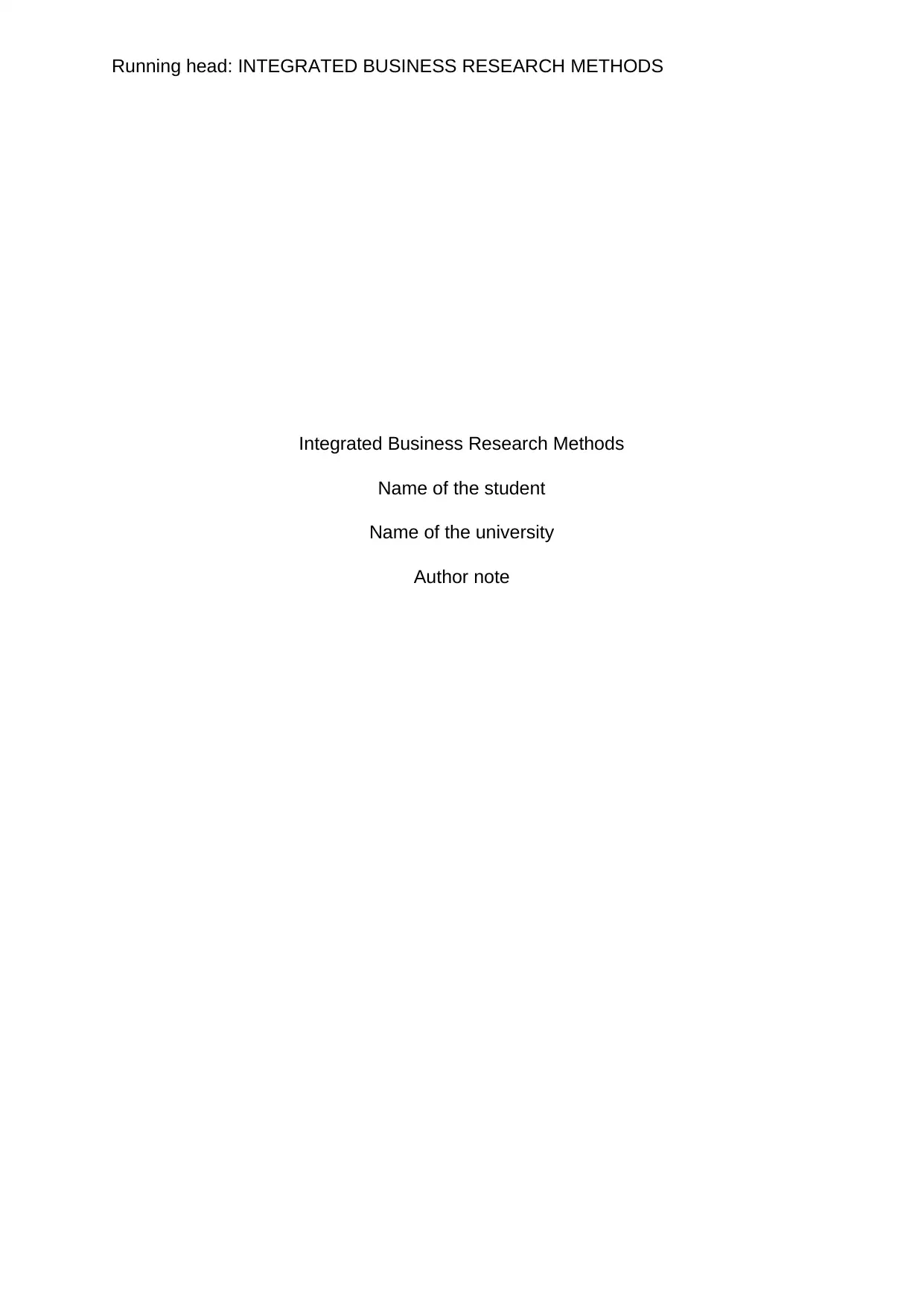
Running head: INTEGRATED BUSINESS RESEARCH METHODS
Integrated Business Research Methods
Name of the student
Name of the university
Author note
Integrated Business Research Methods
Name of the student
Name of the university
Author note
Paraphrase This Document
Need a fresh take? Get an instant paraphrase of this document with our AI Paraphraser
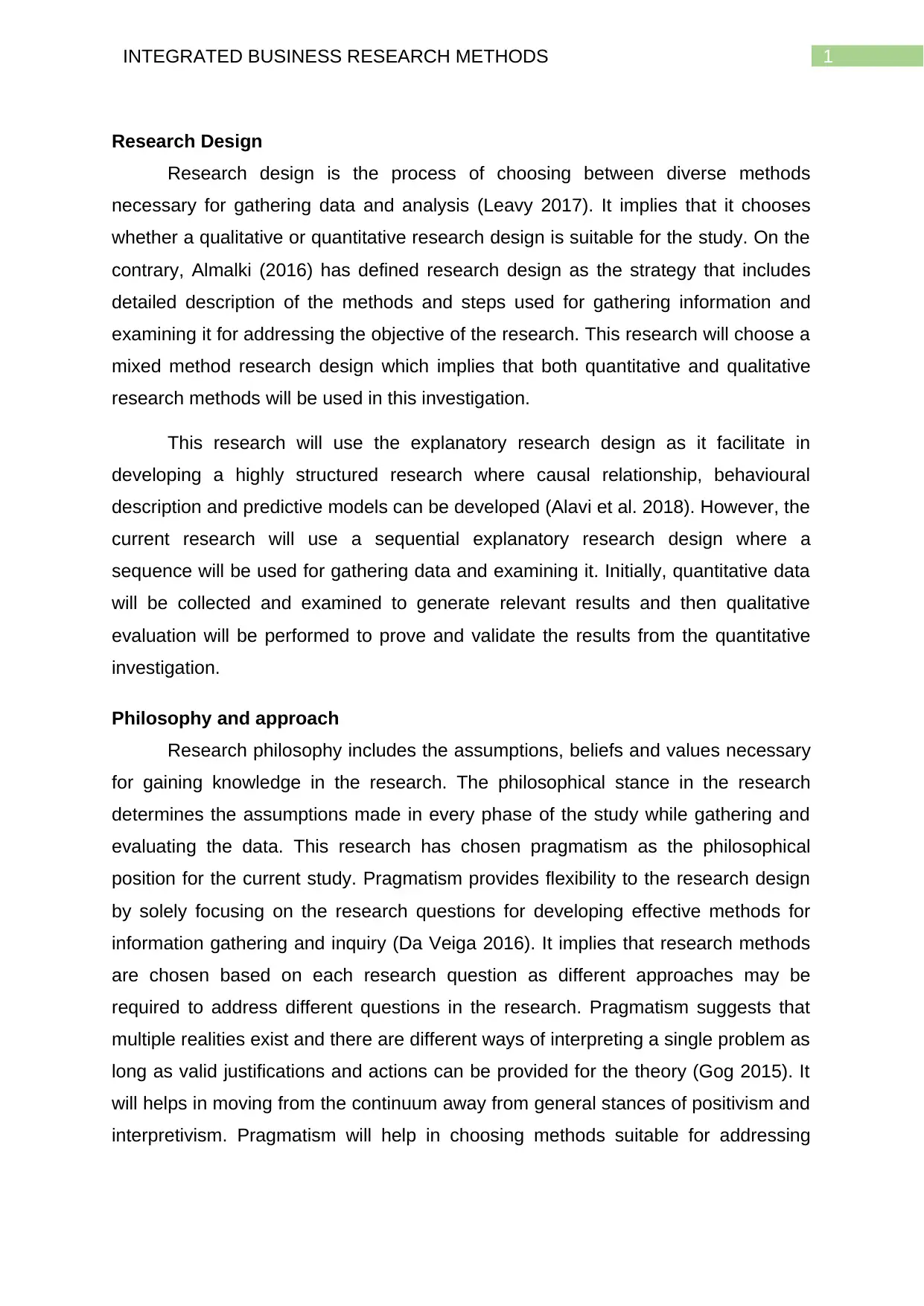
1INTEGRATED BUSINESS RESEARCH METHODS
Research Design
Research design is the process of choosing between diverse methods
necessary for gathering data and analysis (Leavy 2017). It implies that it chooses
whether a qualitative or quantitative research design is suitable for the study. On the
contrary, Almalki (2016) has defined research design as the strategy that includes
detailed description of the methods and steps used for gathering information and
examining it for addressing the objective of the research. This research will choose a
mixed method research design which implies that both quantitative and qualitative
research methods will be used in this investigation.
This research will use the explanatory research design as it facilitate in
developing a highly structured research where causal relationship, behavioural
description and predictive models can be developed (Alavi et al. 2018). However, the
current research will use a sequential explanatory research design where a
sequence will be used for gathering data and examining it. Initially, quantitative data
will be collected and examined to generate relevant results and then qualitative
evaluation will be performed to prove and validate the results from the quantitative
investigation.
Philosophy and approach
Research philosophy includes the assumptions, beliefs and values necessary
for gaining knowledge in the research. The philosophical stance in the research
determines the assumptions made in every phase of the study while gathering and
evaluating the data. This research has chosen pragmatism as the philosophical
position for the current study. Pragmatism provides flexibility to the research design
by solely focusing on the research questions for developing effective methods for
information gathering and inquiry (Da Veiga 2016). It implies that research methods
are chosen based on each research question as different approaches may be
required to address different questions in the research. Pragmatism suggests that
multiple realities exist and there are different ways of interpreting a single problem as
long as valid justifications and actions can be provided for the theory (Gog 2015). It
will helps in moving from the continuum away from general stances of positivism and
interpretivism. Pragmatism will help in choosing methods suitable for addressing
Research Design
Research design is the process of choosing between diverse methods
necessary for gathering data and analysis (Leavy 2017). It implies that it chooses
whether a qualitative or quantitative research design is suitable for the study. On the
contrary, Almalki (2016) has defined research design as the strategy that includes
detailed description of the methods and steps used for gathering information and
examining it for addressing the objective of the research. This research will choose a
mixed method research design which implies that both quantitative and qualitative
research methods will be used in this investigation.
This research will use the explanatory research design as it facilitate in
developing a highly structured research where causal relationship, behavioural
description and predictive models can be developed (Alavi et al. 2018). However, the
current research will use a sequential explanatory research design where a
sequence will be used for gathering data and examining it. Initially, quantitative data
will be collected and examined to generate relevant results and then qualitative
evaluation will be performed to prove and validate the results from the quantitative
investigation.
Philosophy and approach
Research philosophy includes the assumptions, beliefs and values necessary
for gaining knowledge in the research. The philosophical stance in the research
determines the assumptions made in every phase of the study while gathering and
evaluating the data. This research has chosen pragmatism as the philosophical
position for the current study. Pragmatism provides flexibility to the research design
by solely focusing on the research questions for developing effective methods for
information gathering and inquiry (Da Veiga 2016). It implies that research methods
are chosen based on each research question as different approaches may be
required to address different questions in the research. Pragmatism suggests that
multiple realities exist and there are different ways of interpreting a single problem as
long as valid justifications and actions can be provided for the theory (Gog 2015). It
will helps in moving from the continuum away from general stances of positivism and
interpretivism. Pragmatism will help in choosing methods suitable for addressing
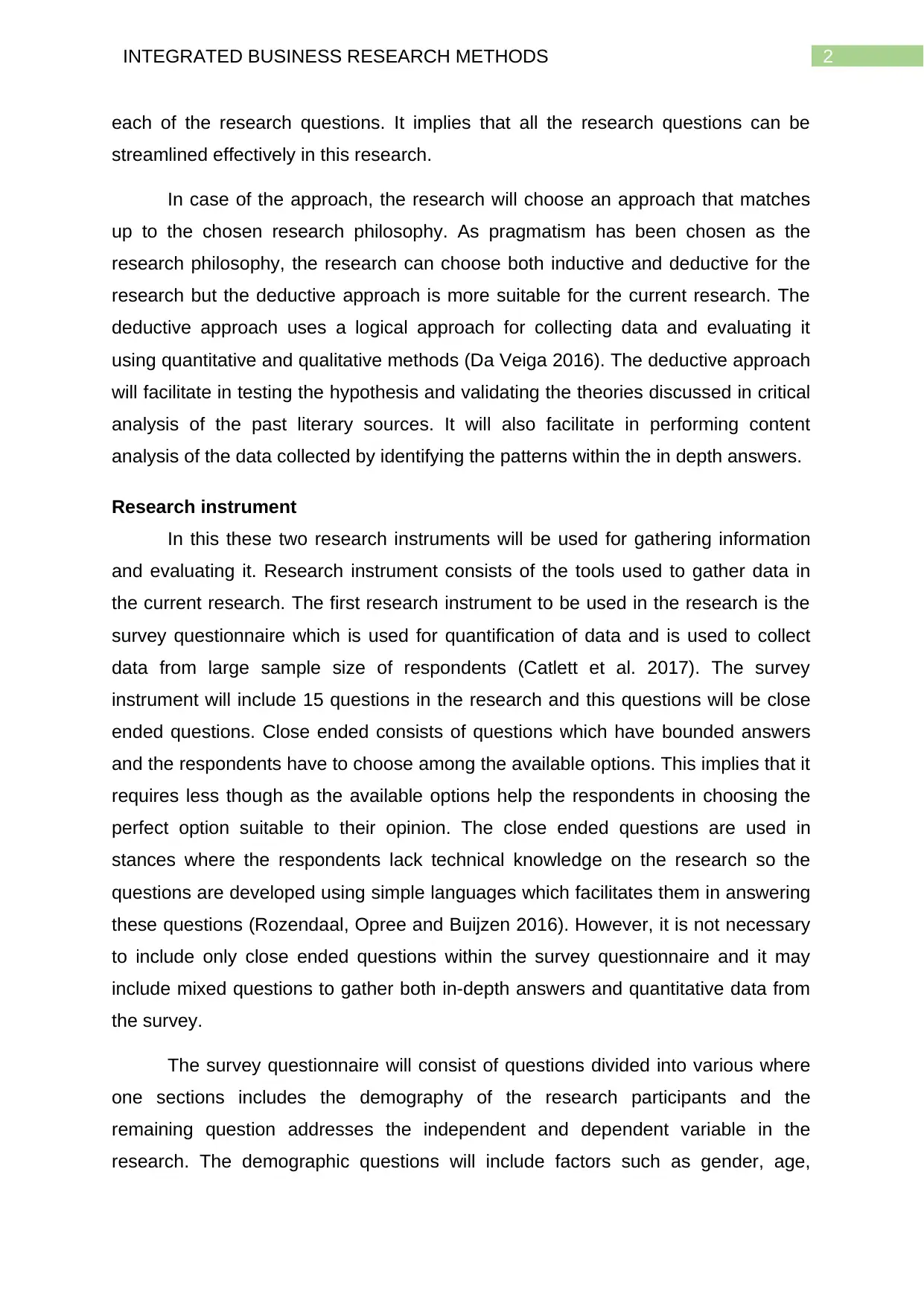
2INTEGRATED BUSINESS RESEARCH METHODS
each of the research questions. It implies that all the research questions can be
streamlined effectively in this research.
In case of the approach, the research will choose an approach that matches
up to the chosen research philosophy. As pragmatism has been chosen as the
research philosophy, the research can choose both inductive and deductive for the
research but the deductive approach is more suitable for the current research. The
deductive approach uses a logical approach for collecting data and evaluating it
using quantitative and qualitative methods (Da Veiga 2016). The deductive approach
will facilitate in testing the hypothesis and validating the theories discussed in critical
analysis of the past literary sources. It will also facilitate in performing content
analysis of the data collected by identifying the patterns within the in depth answers.
Research instrument
In this these two research instruments will be used for gathering information
and evaluating it. Research instrument consists of the tools used to gather data in
the current research. The first research instrument to be used in the research is the
survey questionnaire which is used for quantification of data and is used to collect
data from large sample size of respondents (Catlett et al. 2017). The survey
instrument will include 15 questions in the research and this questions will be close
ended questions. Close ended consists of questions which have bounded answers
and the respondents have to choose among the available options. This implies that it
requires less though as the available options help the respondents in choosing the
perfect option suitable to their opinion. The close ended questions are used in
stances where the respondents lack technical knowledge on the research so the
questions are developed using simple languages which facilitates them in answering
these questions (Rozendaal, Opree and Buijzen 2016). However, it is not necessary
to include only close ended questions within the survey questionnaire and it may
include mixed questions to gather both in-depth answers and quantitative data from
the survey.
The survey questionnaire will consist of questions divided into various where
one sections includes the demography of the research participants and the
remaining question addresses the independent and dependent variable in the
research. The demographic questions will include factors such as gender, age,
each of the research questions. It implies that all the research questions can be
streamlined effectively in this research.
In case of the approach, the research will choose an approach that matches
up to the chosen research philosophy. As pragmatism has been chosen as the
research philosophy, the research can choose both inductive and deductive for the
research but the deductive approach is more suitable for the current research. The
deductive approach uses a logical approach for collecting data and evaluating it
using quantitative and qualitative methods (Da Veiga 2016). The deductive approach
will facilitate in testing the hypothesis and validating the theories discussed in critical
analysis of the past literary sources. It will also facilitate in performing content
analysis of the data collected by identifying the patterns within the in depth answers.
Research instrument
In this these two research instruments will be used for gathering information
and evaluating it. Research instrument consists of the tools used to gather data in
the current research. The first research instrument to be used in the research is the
survey questionnaire which is used for quantification of data and is used to collect
data from large sample size of respondents (Catlett et al. 2017). The survey
instrument will include 15 questions in the research and this questions will be close
ended questions. Close ended consists of questions which have bounded answers
and the respondents have to choose among the available options. This implies that it
requires less though as the available options help the respondents in choosing the
perfect option suitable to their opinion. The close ended questions are used in
stances where the respondents lack technical knowledge on the research so the
questions are developed using simple languages which facilitates them in answering
these questions (Rozendaal, Opree and Buijzen 2016). However, it is not necessary
to include only close ended questions within the survey questionnaire and it may
include mixed questions to gather both in-depth answers and quantitative data from
the survey.
The survey questionnaire will consist of questions divided into various where
one sections includes the demography of the research participants and the
remaining question addresses the independent and dependent variable in the
research. The demographic questions will include factors such as gender, age,
⊘ This is a preview!⊘
Do you want full access?
Subscribe today to unlock all pages.

Trusted by 1+ million students worldwide
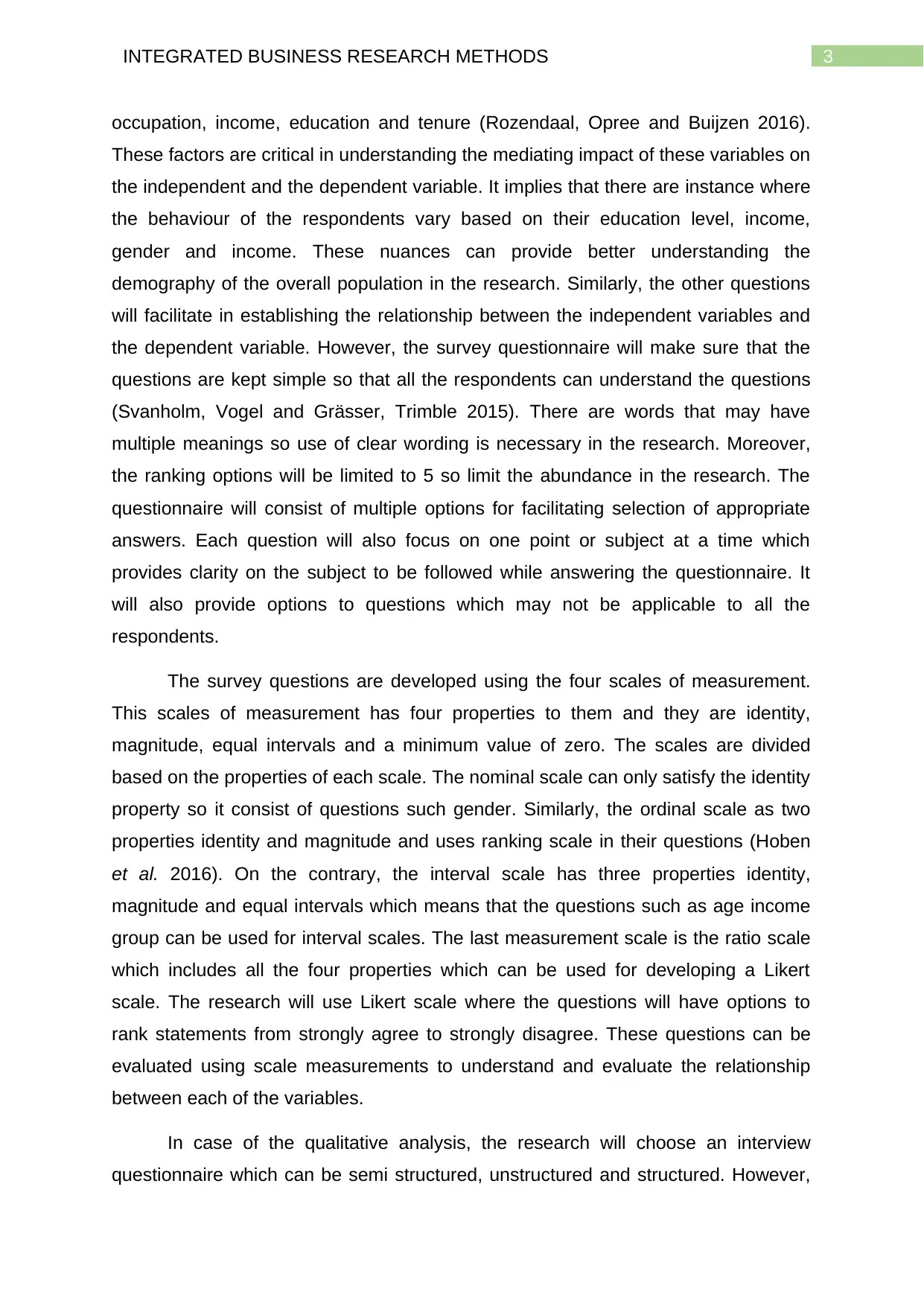
3INTEGRATED BUSINESS RESEARCH METHODS
occupation, income, education and tenure (Rozendaal, Opree and Buijzen 2016).
These factors are critical in understanding the mediating impact of these variables on
the independent and the dependent variable. It implies that there are instance where
the behaviour of the respondents vary based on their education level, income,
gender and income. These nuances can provide better understanding the
demography of the overall population in the research. Similarly, the other questions
will facilitate in establishing the relationship between the independent variables and
the dependent variable. However, the survey questionnaire will make sure that the
questions are kept simple so that all the respondents can understand the questions
(Svanholm, Vogel and Grässer, Trimble 2015). There are words that may have
multiple meanings so use of clear wording is necessary in the research. Moreover,
the ranking options will be limited to 5 so limit the abundance in the research. The
questionnaire will consist of multiple options for facilitating selection of appropriate
answers. Each question will also focus on one point or subject at a time which
provides clarity on the subject to be followed while answering the questionnaire. It
will also provide options to questions which may not be applicable to all the
respondents.
The survey questions are developed using the four scales of measurement.
This scales of measurement has four properties to them and they are identity,
magnitude, equal intervals and a minimum value of zero. The scales are divided
based on the properties of each scale. The nominal scale can only satisfy the identity
property so it consist of questions such gender. Similarly, the ordinal scale as two
properties identity and magnitude and uses ranking scale in their questions (Hoben
et al. 2016). On the contrary, the interval scale has three properties identity,
magnitude and equal intervals which means that the questions such as age income
group can be used for interval scales. The last measurement scale is the ratio scale
which includes all the four properties which can be used for developing a Likert
scale. The research will use Likert scale where the questions will have options to
rank statements from strongly agree to strongly disagree. These questions can be
evaluated using scale measurements to understand and evaluate the relationship
between each of the variables.
In case of the qualitative analysis, the research will choose an interview
questionnaire which can be semi structured, unstructured and structured. However,
occupation, income, education and tenure (Rozendaal, Opree and Buijzen 2016).
These factors are critical in understanding the mediating impact of these variables on
the independent and the dependent variable. It implies that there are instance where
the behaviour of the respondents vary based on their education level, income,
gender and income. These nuances can provide better understanding the
demography of the overall population in the research. Similarly, the other questions
will facilitate in establishing the relationship between the independent variables and
the dependent variable. However, the survey questionnaire will make sure that the
questions are kept simple so that all the respondents can understand the questions
(Svanholm, Vogel and Grässer, Trimble 2015). There are words that may have
multiple meanings so use of clear wording is necessary in the research. Moreover,
the ranking options will be limited to 5 so limit the abundance in the research. The
questionnaire will consist of multiple options for facilitating selection of appropriate
answers. Each question will also focus on one point or subject at a time which
provides clarity on the subject to be followed while answering the questionnaire. It
will also provide options to questions which may not be applicable to all the
respondents.
The survey questions are developed using the four scales of measurement.
This scales of measurement has four properties to them and they are identity,
magnitude, equal intervals and a minimum value of zero. The scales are divided
based on the properties of each scale. The nominal scale can only satisfy the identity
property so it consist of questions such gender. Similarly, the ordinal scale as two
properties identity and magnitude and uses ranking scale in their questions (Hoben
et al. 2016). On the contrary, the interval scale has three properties identity,
magnitude and equal intervals which means that the questions such as age income
group can be used for interval scales. The last measurement scale is the ratio scale
which includes all the four properties which can be used for developing a Likert
scale. The research will use Likert scale where the questions will have options to
rank statements from strongly agree to strongly disagree. These questions can be
evaluated using scale measurements to understand and evaluate the relationship
between each of the variables.
In case of the qualitative analysis, the research will choose an interview
questionnaire which can be semi structured, unstructured and structured. However,
Paraphrase This Document
Need a fresh take? Get an instant paraphrase of this document with our AI Paraphraser
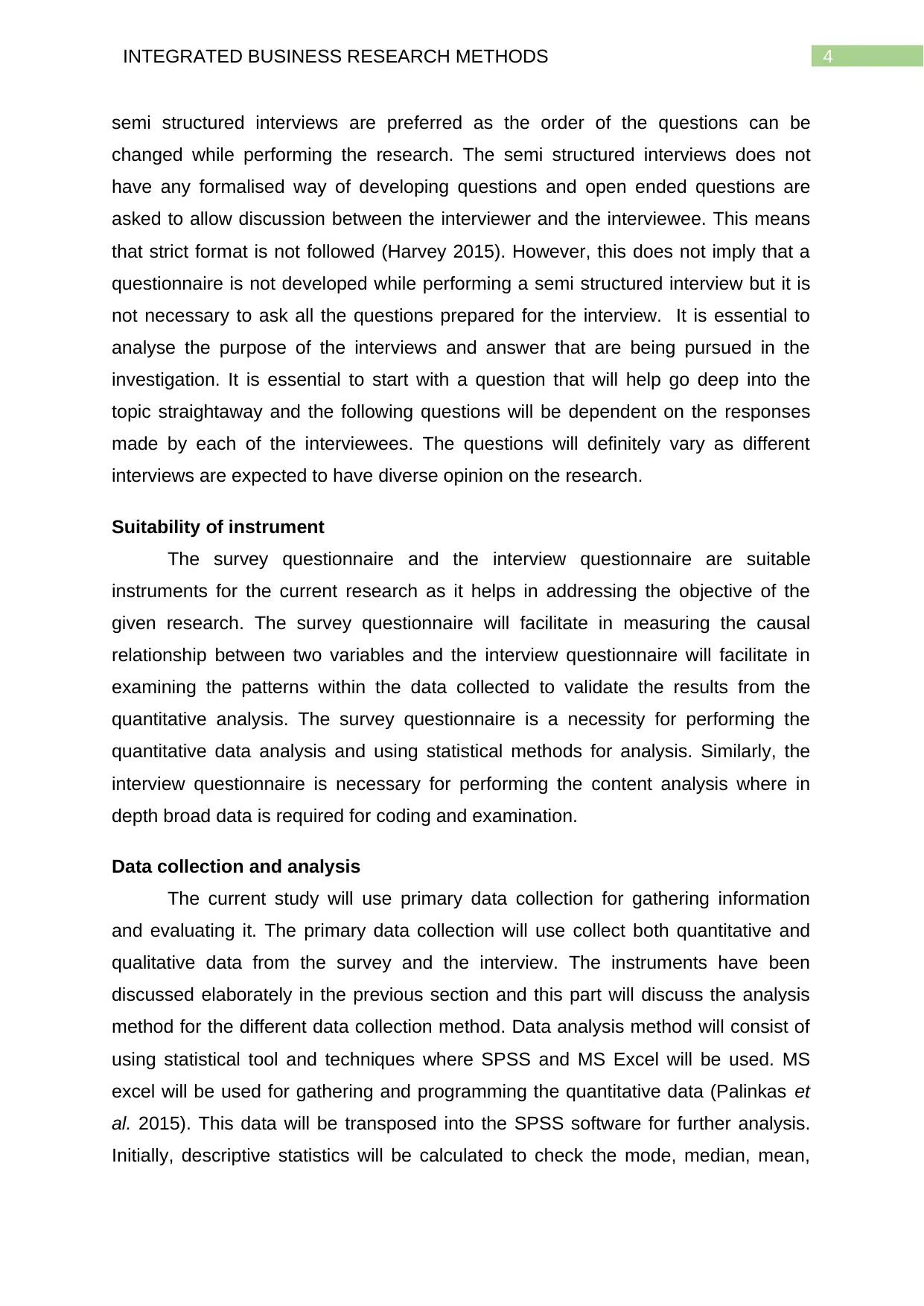
4INTEGRATED BUSINESS RESEARCH METHODS
semi structured interviews are preferred as the order of the questions can be
changed while performing the research. The semi structured interviews does not
have any formalised way of developing questions and open ended questions are
asked to allow discussion between the interviewer and the interviewee. This means
that strict format is not followed (Harvey 2015). However, this does not imply that a
questionnaire is not developed while performing a semi structured interview but it is
not necessary to ask all the questions prepared for the interview. It is essential to
analyse the purpose of the interviews and answer that are being pursued in the
investigation. It is essential to start with a question that will help go deep into the
topic straightaway and the following questions will be dependent on the responses
made by each of the interviewees. The questions will definitely vary as different
interviews are expected to have diverse opinion on the research.
Suitability of instrument
The survey questionnaire and the interview questionnaire are suitable
instruments for the current research as it helps in addressing the objective of the
given research. The survey questionnaire will facilitate in measuring the causal
relationship between two variables and the interview questionnaire will facilitate in
examining the patterns within the data collected to validate the results from the
quantitative analysis. The survey questionnaire is a necessity for performing the
quantitative data analysis and using statistical methods for analysis. Similarly, the
interview questionnaire is necessary for performing the content analysis where in
depth broad data is required for coding and examination.
Data collection and analysis
The current study will use primary data collection for gathering information
and evaluating it. The primary data collection will use collect both quantitative and
qualitative data from the survey and the interview. The instruments have been
discussed elaborately in the previous section and this part will discuss the analysis
method for the different data collection method. Data analysis method will consist of
using statistical tool and techniques where SPSS and MS Excel will be used. MS
excel will be used for gathering and programming the quantitative data (Palinkas et
al. 2015). This data will be transposed into the SPSS software for further analysis.
Initially, descriptive statistics will be calculated to check the mode, median, mean,
semi structured interviews are preferred as the order of the questions can be
changed while performing the research. The semi structured interviews does not
have any formalised way of developing questions and open ended questions are
asked to allow discussion between the interviewer and the interviewee. This means
that strict format is not followed (Harvey 2015). However, this does not imply that a
questionnaire is not developed while performing a semi structured interview but it is
not necessary to ask all the questions prepared for the interview. It is essential to
analyse the purpose of the interviews and answer that are being pursued in the
investigation. It is essential to start with a question that will help go deep into the
topic straightaway and the following questions will be dependent on the responses
made by each of the interviewees. The questions will definitely vary as different
interviews are expected to have diverse opinion on the research.
Suitability of instrument
The survey questionnaire and the interview questionnaire are suitable
instruments for the current research as it helps in addressing the objective of the
given research. The survey questionnaire will facilitate in measuring the causal
relationship between two variables and the interview questionnaire will facilitate in
examining the patterns within the data collected to validate the results from the
quantitative analysis. The survey questionnaire is a necessity for performing the
quantitative data analysis and using statistical methods for analysis. Similarly, the
interview questionnaire is necessary for performing the content analysis where in
depth broad data is required for coding and examination.
Data collection and analysis
The current study will use primary data collection for gathering information
and evaluating it. The primary data collection will use collect both quantitative and
qualitative data from the survey and the interview. The instruments have been
discussed elaborately in the previous section and this part will discuss the analysis
method for the different data collection method. Data analysis method will consist of
using statistical tool and techniques where SPSS and MS Excel will be used. MS
excel will be used for gathering and programming the quantitative data (Palinkas et
al. 2015). This data will be transposed into the SPSS software for further analysis.
Initially, descriptive statistics will be calculated to check the mode, median, mean,
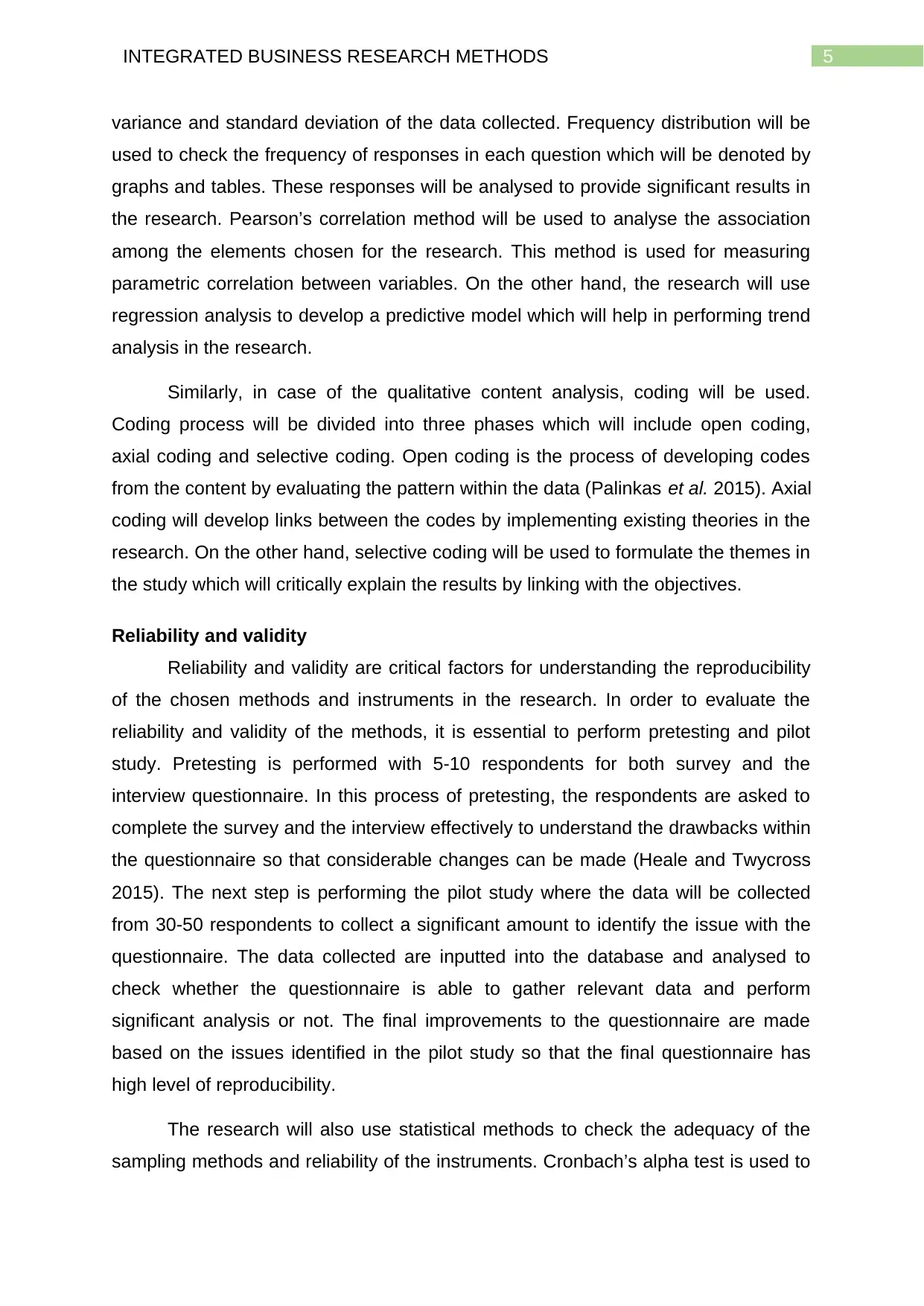
5INTEGRATED BUSINESS RESEARCH METHODS
variance and standard deviation of the data collected. Frequency distribution will be
used to check the frequency of responses in each question which will be denoted by
graphs and tables. These responses will be analysed to provide significant results in
the research. Pearson’s correlation method will be used to analyse the association
among the elements chosen for the research. This method is used for measuring
parametric correlation between variables. On the other hand, the research will use
regression analysis to develop a predictive model which will help in performing trend
analysis in the research.
Similarly, in case of the qualitative content analysis, coding will be used.
Coding process will be divided into three phases which will include open coding,
axial coding and selective coding. Open coding is the process of developing codes
from the content by evaluating the pattern within the data (Palinkas et al. 2015). Axial
coding will develop links between the codes by implementing existing theories in the
research. On the other hand, selective coding will be used to formulate the themes in
the study which will critically explain the results by linking with the objectives.
Reliability and validity
Reliability and validity are critical factors for understanding the reproducibility
of the chosen methods and instruments in the research. In order to evaluate the
reliability and validity of the methods, it is essential to perform pretesting and pilot
study. Pretesting is performed with 5-10 respondents for both survey and the
interview questionnaire. In this process of pretesting, the respondents are asked to
complete the survey and the interview effectively to understand the drawbacks within
the questionnaire so that considerable changes can be made (Heale and Twycross
2015). The next step is performing the pilot study where the data will be collected
from 30-50 respondents to collect a significant amount to identify the issue with the
questionnaire. The data collected are inputted into the database and analysed to
check whether the questionnaire is able to gather relevant data and perform
significant analysis or not. The final improvements to the questionnaire are made
based on the issues identified in the pilot study so that the final questionnaire has
high level of reproducibility.
The research will also use statistical methods to check the adequacy of the
sampling methods and reliability of the instruments. Cronbach’s alpha test is used to
variance and standard deviation of the data collected. Frequency distribution will be
used to check the frequency of responses in each question which will be denoted by
graphs and tables. These responses will be analysed to provide significant results in
the research. Pearson’s correlation method will be used to analyse the association
among the elements chosen for the research. This method is used for measuring
parametric correlation between variables. On the other hand, the research will use
regression analysis to develop a predictive model which will help in performing trend
analysis in the research.
Similarly, in case of the qualitative content analysis, coding will be used.
Coding process will be divided into three phases which will include open coding,
axial coding and selective coding. Open coding is the process of developing codes
from the content by evaluating the pattern within the data (Palinkas et al. 2015). Axial
coding will develop links between the codes by implementing existing theories in the
research. On the other hand, selective coding will be used to formulate the themes in
the study which will critically explain the results by linking with the objectives.
Reliability and validity
Reliability and validity are critical factors for understanding the reproducibility
of the chosen methods and instruments in the research. In order to evaluate the
reliability and validity of the methods, it is essential to perform pretesting and pilot
study. Pretesting is performed with 5-10 respondents for both survey and the
interview questionnaire. In this process of pretesting, the respondents are asked to
complete the survey and the interview effectively to understand the drawbacks within
the questionnaire so that considerable changes can be made (Heale and Twycross
2015). The next step is performing the pilot study where the data will be collected
from 30-50 respondents to collect a significant amount to identify the issue with the
questionnaire. The data collected are inputted into the database and analysed to
check whether the questionnaire is able to gather relevant data and perform
significant analysis or not. The final improvements to the questionnaire are made
based on the issues identified in the pilot study so that the final questionnaire has
high level of reproducibility.
The research will also use statistical methods to check the adequacy of the
sampling methods and reliability of the instruments. Cronbach’s alpha test is used to
⊘ This is a preview!⊘
Do you want full access?
Subscribe today to unlock all pages.

Trusted by 1+ million students worldwide
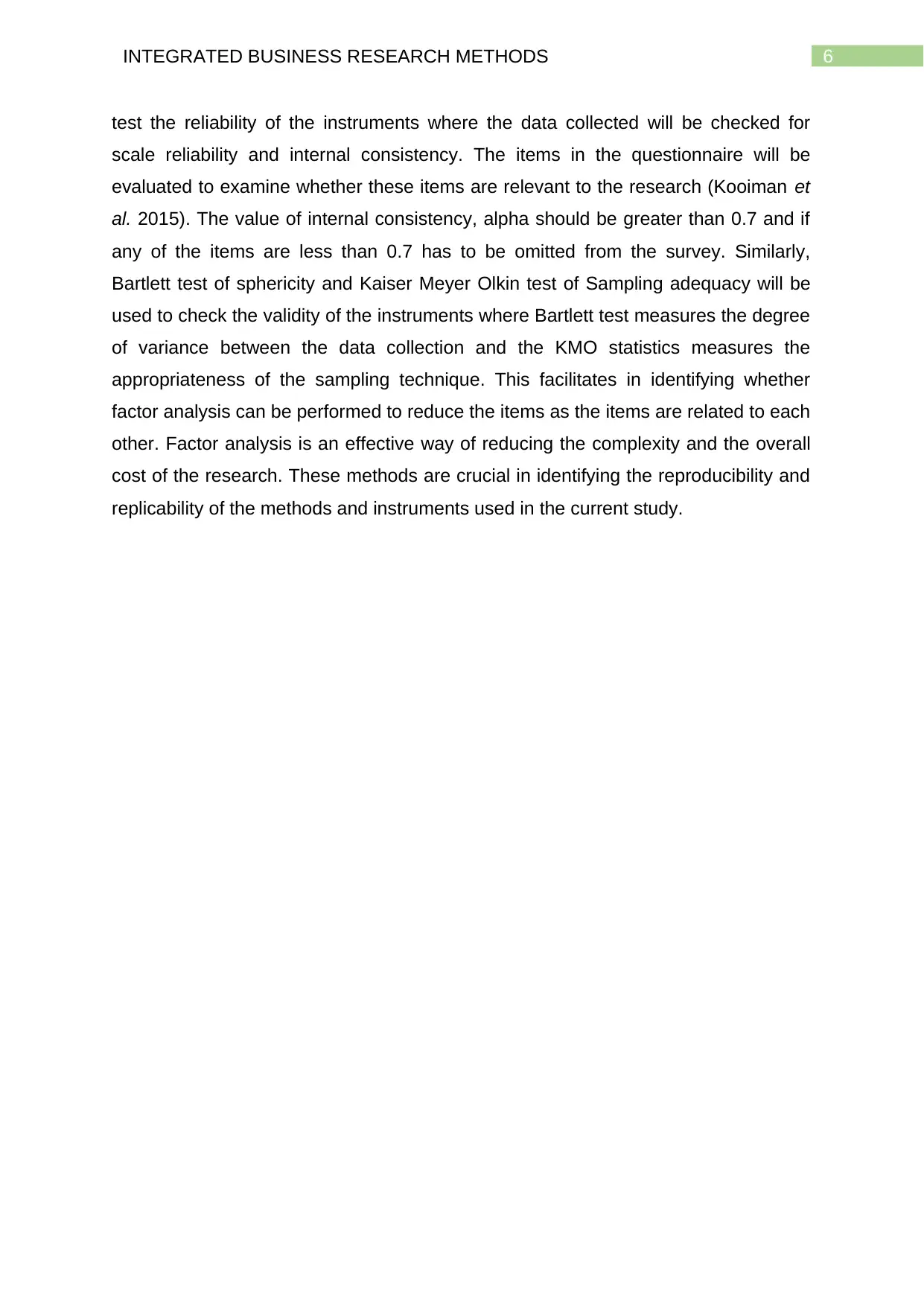
6INTEGRATED BUSINESS RESEARCH METHODS
test the reliability of the instruments where the data collected will be checked for
scale reliability and internal consistency. The items in the questionnaire will be
evaluated to examine whether these items are relevant to the research (Kooiman et
al. 2015). The value of internal consistency, alpha should be greater than 0.7 and if
any of the items are less than 0.7 has to be omitted from the survey. Similarly,
Bartlett test of sphericity and Kaiser Meyer Olkin test of Sampling adequacy will be
used to check the validity of the instruments where Bartlett test measures the degree
of variance between the data collection and the KMO statistics measures the
appropriateness of the sampling technique. This facilitates in identifying whether
factor analysis can be performed to reduce the items as the items are related to each
other. Factor analysis is an effective way of reducing the complexity and the overall
cost of the research. These methods are crucial in identifying the reproducibility and
replicability of the methods and instruments used in the current study.
test the reliability of the instruments where the data collected will be checked for
scale reliability and internal consistency. The items in the questionnaire will be
evaluated to examine whether these items are relevant to the research (Kooiman et
al. 2015). The value of internal consistency, alpha should be greater than 0.7 and if
any of the items are less than 0.7 has to be omitted from the survey. Similarly,
Bartlett test of sphericity and Kaiser Meyer Olkin test of Sampling adequacy will be
used to check the validity of the instruments where Bartlett test measures the degree
of variance between the data collection and the KMO statistics measures the
appropriateness of the sampling technique. This facilitates in identifying whether
factor analysis can be performed to reduce the items as the items are related to each
other. Factor analysis is an effective way of reducing the complexity and the overall
cost of the research. These methods are crucial in identifying the reproducibility and
replicability of the methods and instruments used in the current study.
Paraphrase This Document
Need a fresh take? Get an instant paraphrase of this document with our AI Paraphraser
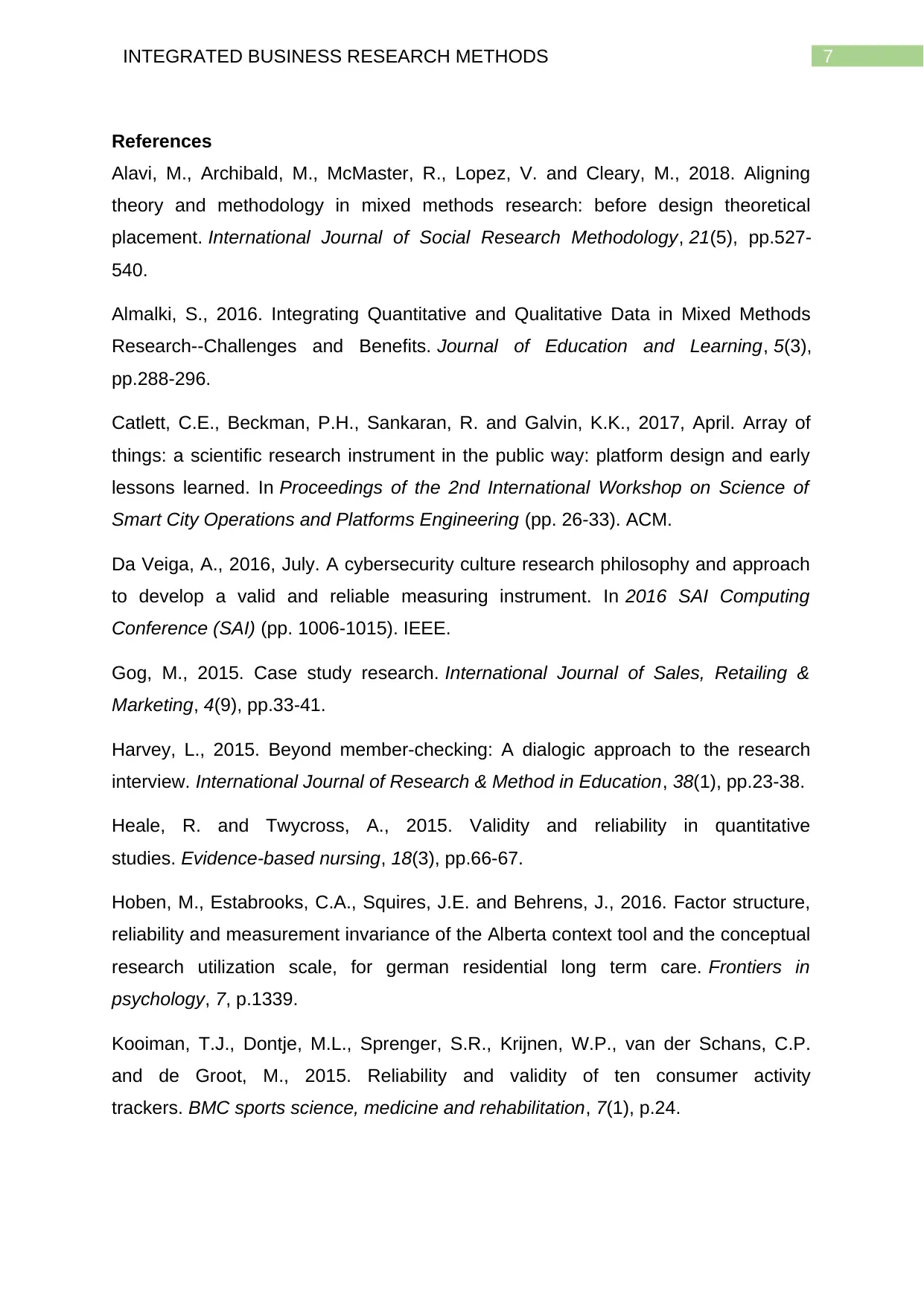
7INTEGRATED BUSINESS RESEARCH METHODS
References
Alavi, M., Archibald, M., McMaster, R., Lopez, V. and Cleary, M., 2018. Aligning
theory and methodology in mixed methods research: before design theoretical
placement. International Journal of Social Research Methodology, 21(5), pp.527-
540.
Almalki, S., 2016. Integrating Quantitative and Qualitative Data in Mixed Methods
Research--Challenges and Benefits. Journal of Education and Learning, 5(3),
pp.288-296.
Catlett, C.E., Beckman, P.H., Sankaran, R. and Galvin, K.K., 2017, April. Array of
things: a scientific research instrument in the public way: platform design and early
lessons learned. In Proceedings of the 2nd International Workshop on Science of
Smart City Operations and Platforms Engineering (pp. 26-33). ACM.
Da Veiga, A., 2016, July. A cybersecurity culture research philosophy and approach
to develop a valid and reliable measuring instrument. In 2016 SAI Computing
Conference (SAI) (pp. 1006-1015). IEEE.
Gog, M., 2015. Case study research. International Journal of Sales, Retailing &
Marketing, 4(9), pp.33-41.
Harvey, L., 2015. Beyond member-checking: A dialogic approach to the research
interview. International Journal of Research & Method in Education, 38(1), pp.23-38.
Heale, R. and Twycross, A., 2015. Validity and reliability in quantitative
studies. Evidence-based nursing, 18(3), pp.66-67.
Hoben, M., Estabrooks, C.A., Squires, J.E. and Behrens, J., 2016. Factor structure,
reliability and measurement invariance of the Alberta context tool and the conceptual
research utilization scale, for german residential long term care. Frontiers in
psychology, 7, p.1339.
Kooiman, T.J., Dontje, M.L., Sprenger, S.R., Krijnen, W.P., van der Schans, C.P.
and de Groot, M., 2015. Reliability and validity of ten consumer activity
trackers. BMC sports science, medicine and rehabilitation, 7(1), p.24.
References
Alavi, M., Archibald, M., McMaster, R., Lopez, V. and Cleary, M., 2018. Aligning
theory and methodology in mixed methods research: before design theoretical
placement. International Journal of Social Research Methodology, 21(5), pp.527-
540.
Almalki, S., 2016. Integrating Quantitative and Qualitative Data in Mixed Methods
Research--Challenges and Benefits. Journal of Education and Learning, 5(3),
pp.288-296.
Catlett, C.E., Beckman, P.H., Sankaran, R. and Galvin, K.K., 2017, April. Array of
things: a scientific research instrument in the public way: platform design and early
lessons learned. In Proceedings of the 2nd International Workshop on Science of
Smart City Operations and Platforms Engineering (pp. 26-33). ACM.
Da Veiga, A., 2016, July. A cybersecurity culture research philosophy and approach
to develop a valid and reliable measuring instrument. In 2016 SAI Computing
Conference (SAI) (pp. 1006-1015). IEEE.
Gog, M., 2015. Case study research. International Journal of Sales, Retailing &
Marketing, 4(9), pp.33-41.
Harvey, L., 2015. Beyond member-checking: A dialogic approach to the research
interview. International Journal of Research & Method in Education, 38(1), pp.23-38.
Heale, R. and Twycross, A., 2015. Validity and reliability in quantitative
studies. Evidence-based nursing, 18(3), pp.66-67.
Hoben, M., Estabrooks, C.A., Squires, J.E. and Behrens, J., 2016. Factor structure,
reliability and measurement invariance of the Alberta context tool and the conceptual
research utilization scale, for german residential long term care. Frontiers in
psychology, 7, p.1339.
Kooiman, T.J., Dontje, M.L., Sprenger, S.R., Krijnen, W.P., van der Schans, C.P.
and de Groot, M., 2015. Reliability and validity of ten consumer activity
trackers. BMC sports science, medicine and rehabilitation, 7(1), p.24.
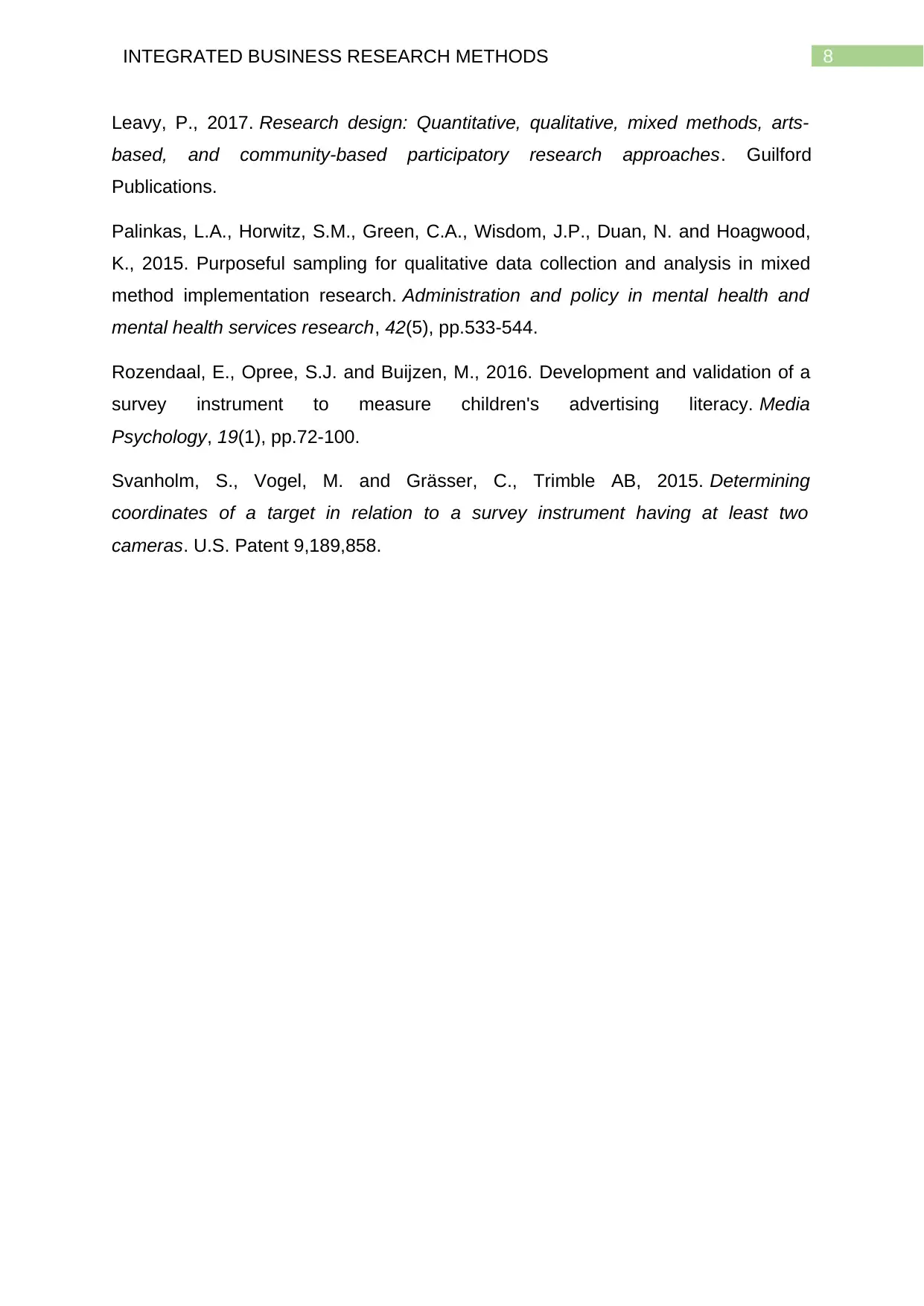
8INTEGRATED BUSINESS RESEARCH METHODS
Leavy, P., 2017. Research design: Quantitative, qualitative, mixed methods, arts-
based, and community-based participatory research approaches. Guilford
Publications.
Palinkas, L.A., Horwitz, S.M., Green, C.A., Wisdom, J.P., Duan, N. and Hoagwood,
K., 2015. Purposeful sampling for qualitative data collection and analysis in mixed
method implementation research. Administration and policy in mental health and
mental health services research, 42(5), pp.533-544.
Rozendaal, E., Opree, S.J. and Buijzen, M., 2016. Development and validation of a
survey instrument to measure children's advertising literacy. Media
Psychology, 19(1), pp.72-100.
Svanholm, S., Vogel, M. and Grässer, C., Trimble AB, 2015. Determining
coordinates of a target in relation to a survey instrument having at least two
cameras. U.S. Patent 9,189,858.
Leavy, P., 2017. Research design: Quantitative, qualitative, mixed methods, arts-
based, and community-based participatory research approaches. Guilford
Publications.
Palinkas, L.A., Horwitz, S.M., Green, C.A., Wisdom, J.P., Duan, N. and Hoagwood,
K., 2015. Purposeful sampling for qualitative data collection and analysis in mixed
method implementation research. Administration and policy in mental health and
mental health services research, 42(5), pp.533-544.
Rozendaal, E., Opree, S.J. and Buijzen, M., 2016. Development and validation of a
survey instrument to measure children's advertising literacy. Media
Psychology, 19(1), pp.72-100.
Svanholm, S., Vogel, M. and Grässer, C., Trimble AB, 2015. Determining
coordinates of a target in relation to a survey instrument having at least two
cameras. U.S. Patent 9,189,858.
⊘ This is a preview!⊘
Do you want full access?
Subscribe today to unlock all pages.

Trusted by 1+ million students worldwide
1 out of 9
Related Documents
Your All-in-One AI-Powered Toolkit for Academic Success.
+13062052269
info@desklib.com
Available 24*7 on WhatsApp / Email
![[object Object]](/_next/static/media/star-bottom.7253800d.svg)
Unlock your academic potential
Copyright © 2020–2025 A2Z Services. All Rights Reserved. Developed and managed by ZUCOL.





